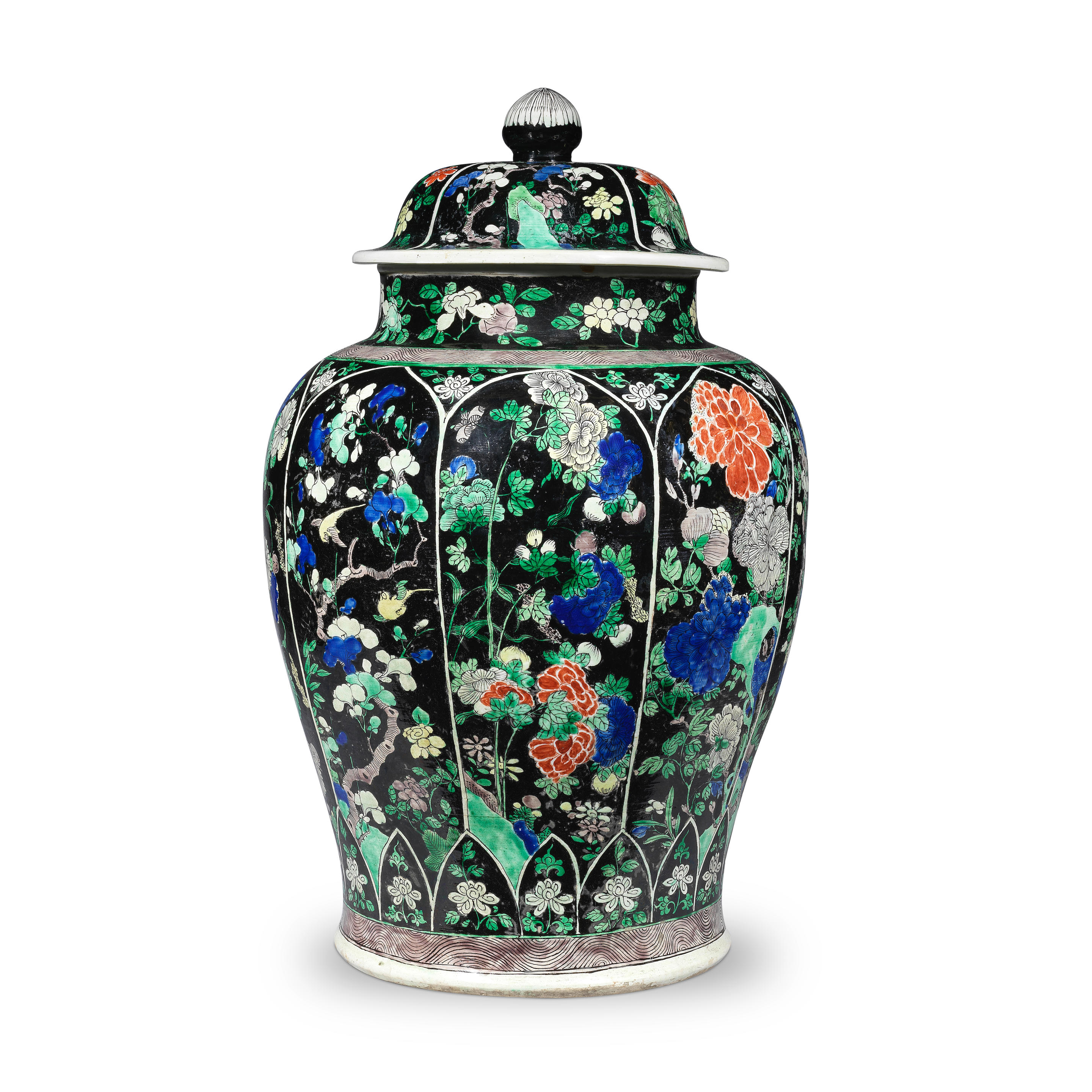A RARE FAMILLE-NOIRE ENAMELED 'PARROT' MALLET VASEKangxi Period
Lively painted on the biscuit porcelain body with a white parrot holding a small prunus stalk in its foot and pecking on the gnarled branch, the dense prunus blossoms and bamboo sprays painted in green, yellow and aubergine, the ground evenly enameled in black, the other side with a two-verse poem reversed in white, the top of the square shoulders decorated with five clouds over yellow ground within green borders, the straight neck painted with bamboo, lingzhi fungus and butterflies of the same color scheme, the top of the flat everted rim and interior glazed white, all supported by a neatly pared ring foot showing fine porcelain body, the base with a double-circle in underglaze blue.
10 3/4in (27.3cm) highFootnotes清康熙 墨地素三彩鸚鵡梅竹詩纹棒槌瓶
Provenance:
From the collection of Otto Fukushima (1871-1952), and thence by inheritance within the family
來源:
Otto Fukushima (1871-1952)舊藏,後於家族內承繼
The poem in running script may be read as: 和靖本無家 鸚禽來誦經, possibly paying homage to the Northern Song dynasty poet and hermit Lin Bu (967-1028), posthumous title Hejing, who lived in Hangzhou and known for adopting prunus trees as his 'wife' and cranes as his 'children'.
The gnarled blossoming prunus tree and bamboo sprays are iconic motifs in famille-noire porcelains, but the white parrot and the two-verse poem are rarely seen.
The parrot appeared in Buddhist traditions as early as the Jakata tales, the voluminous body of literature native to India. As Buddhism evolved and taking roots in China, parrot as an iconography also entered popular culture. The bird is said to have the ability of reciting sutra, as described in the poem written on the present vase. The white parrot is the protagonist of the Yingge baojuan (鸚哥寶卷, Precious Volume of the Parrot), a 16th century folktale with moral lessons performed at temples and private Buddhistic events. The imagery of a white parrot is often seen hovering by the side of Nanhai Guanyin (Guanyin of the South Sea), carrying prayer beads in its mouth.
The five-character two-verse poem on this vase is another rare feature. The characters dominate the entire side of the vase, contrasted by the thick black ground with only tips of the prunus blossom seen on the periphery. Compare, for example, the 17th century powder-blue brush pot with large reverse-white inscriptions, in the collection of the Metropolitan Museum of Art, illustrated on the museum's website, accession number 2015.500.7.2, Gift of Florence and Herbert Irving, 2015.
A RARE FAMILLE-NOIRE ENAMELED 'PARROT' MALLET VASEKangxi Period
Lively painted on the biscuit porcelain body with a white parrot holding a small prunus stalk in its foot and pecking on the gnarled branch, the dense prunus blossoms and bamboo sprays painted in green, yellow and aubergine, the ground evenly enameled in black, the other side with a two-verse poem reversed in white, the top of the square shoulders decorated with five clouds over yellow ground within green borders, the straight neck painted with bamboo, lingzhi fungus and butterflies of the same color scheme, the top of the flat everted rim and interior glazed white, all supported by a neatly pared ring foot showing fine porcelain body, the base with a double-circle in underglaze blue.
10 3/4in (27.3cm) highFootnotes清康熙 墨地素三彩鸚鵡梅竹詩纹棒槌瓶
Provenance:
From the collection of Otto Fukushima (1871-1952), and thence by inheritance within the family
來源:
Otto Fukushima (1871-1952)舊藏,後於家族內承繼
The poem in running script may be read as: 和靖本無家 鸚禽來誦經, possibly paying homage to the Northern Song dynasty poet and hermit Lin Bu (967-1028), posthumous title Hejing, who lived in Hangzhou and known for adopting prunus trees as his 'wife' and cranes as his 'children'.
The gnarled blossoming prunus tree and bamboo sprays are iconic motifs in famille-noire porcelains, but the white parrot and the two-verse poem are rarely seen.
The parrot appeared in Buddhist traditions as early as the Jakata tales, the voluminous body of literature native to India. As Buddhism evolved and taking roots in China, parrot as an iconography also entered popular culture. The bird is said to have the ability of reciting sutra, as described in the poem written on the present vase. The white parrot is the protagonist of the Yingge baojuan (鸚哥寶卷, Precious Volume of the Parrot), a 16th century folktale with moral lessons performed at temples and private Buddhistic events. The imagery of a white parrot is often seen hovering by the side of Nanhai Guanyin (Guanyin of the South Sea), carrying prayer beads in its mouth.
The five-character two-verse poem on this vase is another rare feature. The characters dominate the entire side of the vase, contrasted by the thick black ground with only tips of the prunus blossom seen on the periphery. Compare, for example, the 17th century powder-blue brush pot with large reverse-white inscriptions, in the collection of the Metropolitan Museum of Art, illustrated on the museum's website, accession number 2015.500.7.2, Gift of Florence and Herbert Irving, 2015.






.jpg?w=400)








Testen Sie LotSearch und seine Premium-Features 7 Tage - ohne Kosten!
Lassen Sie sich automatisch über neue Objekte in kommenden Auktionen benachrichtigen.
Suchauftrag anlegen